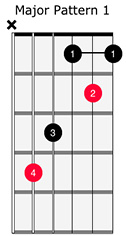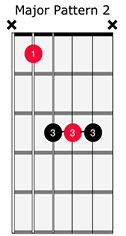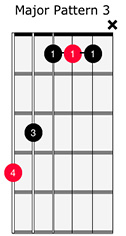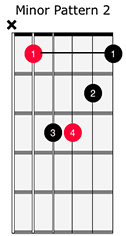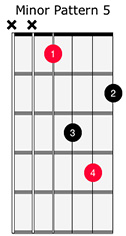Rhythm Guitar 203 - Major And Minor Chord Shapes
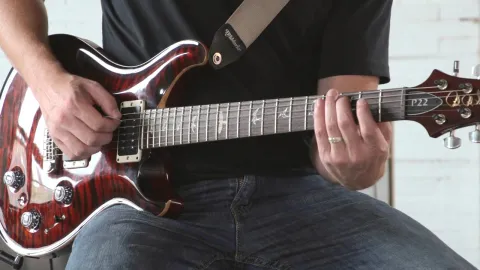
Your rhythm guitar playing has gaps - gaping holes. These movable shapes will fill them. Currently, the only movable shapes we have are our patterns 2 and 4 barre chords. You need the other three patterns for both major and minor chords to completely know your fretboard. Below, I have provided the diagrams for major and minor chords in all five patterns. Some of these patterns are strange to the fingers, and might not be used very often. Others are very easy and are overused if you ask me. You need to know them all and be able to grab them without hesitation.
There are many different reasons to use specific chord shapes instead of others. Sometimes we want to use a specific chord shape to get a specific sound from our chords. Other times we may want to be economical in our movement around the neck. This is especially true when playing long, live sets. This lesson is designed to get you accustomed to finding your "closest move" or most “economical transition” by utilizing all of the five chord shapes available.
Below I have supplied the table of our five most common keys. Like before, we are going to play our two most common progressions (I IV V & I VI II V) in each of the five keys. This time, however, we will be using our "closest moves." This means we will not be going up or down the neck more than one fret to reach our desired chord.
Let’s start in the key of C with the I IV V progression. Choose any strumming pattern you like. In open position, the patterns of choice are C major pattern 1, F major pattern 4, and G major pattern 3. After playing our progression in that area of the neck, we are now going to increase each of the pattern numbers by one and subsequently climb the fretboard. Therefore, C pattern one will become C pattern 2, F pattern 4 will become F pattern 5, and G pattern 3 will become G pattern 4. This will take us to the next position of this progression on the fretboard. After a minute, continue up the neck. C will progress to pattern 3, F to pattern 1, and G to pattern 5. Take this all the way up the neck until you have played the progression in all five possible sections of the fretboard. Try this method in all of the five keys listed and in the I VI II V progression.
There is one more thing we need to introduce: minor progressions. A minor progression is a progression where a minor chord acts as the I chord, or home, just like the minor root does when improvising in the minor pentatonic scale. The most common minor progression is a minor I IV V. The root movements will be the same as a major I IV V, but the chord shapes will be different. I am not going to get into too much theory right now, so just know that minor chords can be key centers as well. I have added a few minor I IV V progressions below.
Really get into this stuff. This is stuff that separates those who just play guitar and those who really know their guitar.
Major keys
|
I major |
II minor |
III minor |
IV major |
V major |
VI minor |
VII dim |
|
C |
D |
E |
F |
G |
A |
B |
|
G |
A |
B |
C |
D |
E |
F# |
|
D |
E |
F# |
G |
A |
B |
C# |
|
A |
B |
C# |
D |
E |
F# |
G# |
|
E |
F# |
G# |
A |
B |
C# |
D# |
Minor keys
|
I minor |
II dim |
bIII major |
IV minor |
V minor |
bVI major |
bVII major |
|
A |
B |
C |
D |
E |
F |
G |
|
D |
E |
F |
G |
A |
Bb |
C |
|
E |
F# |
G |
A |
B |
C |
D |
